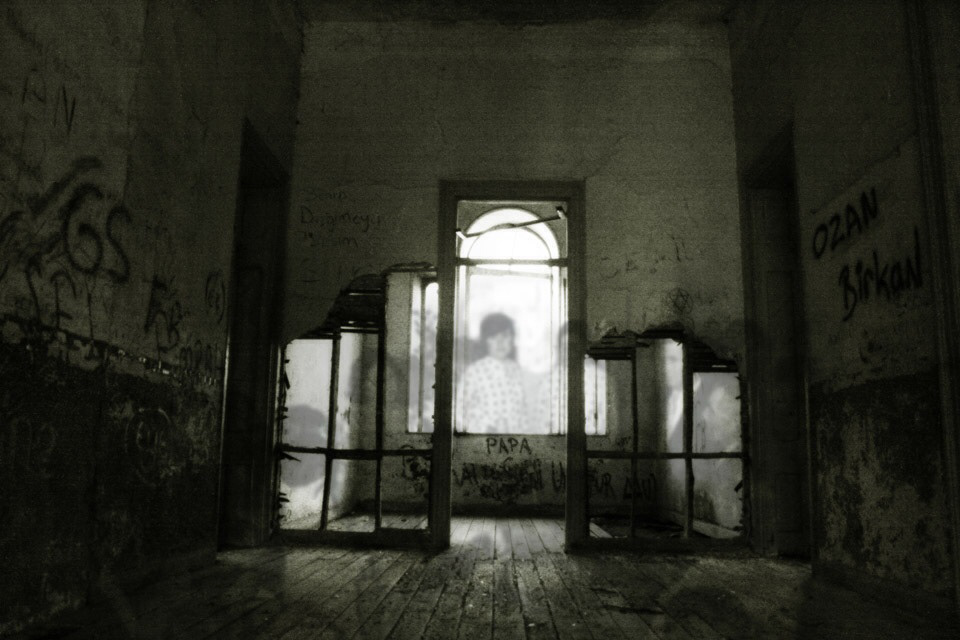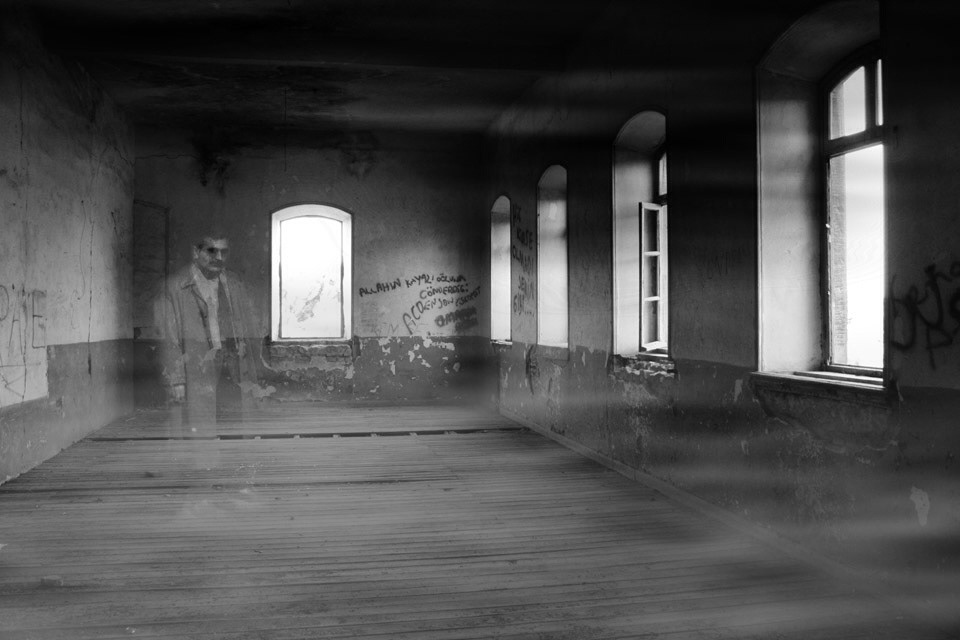










<iframe src="//player.vimeo.com/video/36079469" width="500" height="375" frameborder="0" webkitallowfullscreen mozallowfullscreen allowfullscreen></iframe> <p><a href="http://vimeo.com/36079469">“Or Yehuda”nın Hayaletleri</a> from <a href="http://vimeo.com/mertcakir">mertowskhi</a> on <a href="https://vimeo.com">Vimeo</a>.</p>”
Mert ÇAKIR & Ezgi TEKEREK
The road lies before us. Tobacco plantations and olive tress by the roadside… Quite a familiar Aegean scenery indeed… We are on our way to an old school and the only thing we know about it is its name: Historical Kayalıoğlu Agricultural School.
We weren’t expecting to witness such a great history in Akhisar’s tiny Kayalıoğlu village. It’s “great”, not because of the building’s size, but because of its history going back to the 1900’s and of the fact that we learned why the Jews, who are very much advanced in agriculture, still care about it even today. Kayalıoğlu Agricultural School, alias “Or Yehuda”, was built in order for the Jews to become skilled in agriculture, who, in the past, had fallen behind in agricultural activities for quite some time. Now, the ghosts inside tell us about the transformation it has undergone over the years: from an enormous 28,000-acre center of profession to an abandoned building today…
Following the expulsion from their native land -the Iberian Peninsula- the Sephardim was dispersed and settled into several Ottoman cities to yield agriculture as their main economic activity and focus on trading instead. Agriculture meant attachment and permanent settlement; something that heightened their hesitation about a settled life as a result of the exile from their homeland. That brought the backset for agriculture.
The Jews living in France established various associations in the 19thcentury to give material and financial support to the underdeveloped Jewish communions of the Eastern world. The Alliance Israelite Universelle and the Jewish Colonization Association were two of those institutions that are known to have established around 60 schools in Iran, North Africa and the Ottoman territories,.
The first Jewish agricultural school within the limits of the Ottomon Empire, namely “Mikveh Israel”, was established by Sultan Abdülaziz in Palestine. Later on, by the initiative of the Jewish Association Colonization, the others followed as “Mesila Hadaşa” in Istanbul, “Mamure” in Eskişehir, “Fethiköy” in Silivri, “Tekfur Çiftlik” in Balıkesir and “Or Yehuda” in Akhisar.
Before the establishment of “Or Yehuda” in Akhisar, an agricultural school with a garden was founded in Izmir in 1890 in order to develop and extend agricultural activites in the region. This school had trained 60 impoverished children from Jewish parents but later, in 1900, was moved to Çakıroğlu Plantation (modern Kayaoğlu town today) next to Akhisar due to its insufficient landed property. This is where “Or Yehuda”, alias Historical Kayalıoğlu Agricultural School was constructed.
The construction project was prepared by an architecture from Izmir, M. Magnifico, whose work was later sent to the Central Committee in Paris to be approved by the Agriculture Council of the Jewish Colonization Association on October 9, 1904. The Council decided to spend 73,000 franc for the construction and 11,600 franc for the restoration of buildings. One year later, the school was ready for the students to settle in.
This way an agricultural colony was set up on a land of 28,000 acres, around 2,575 hectares, in Kayalıoğlu town. This colony included work shops for ironworking, ploughing and carpentry, as well as structures like granary, cheese mill and warehouse, wine cellar, school and dormitory. Silk farming, vine cultivation, winemaking, orcharding, cereal production, olive cultivation and stockbreeding were other additional practices.
The 600-acre vineyard was consisted of eight sections where each segment was named after a reputed Jew like Vigne Clara, Hirsch, Mauricia, Netter Ciremieux, Montefiore, Phippson, Leven, Icass, etc...
450 local and Eastern European students from impoverished Jewish families were trained in this school. The standard period of study was 3 years but those who wanted to gain expertise would study up to 4 to 5 years. Students of all ages would have a chance to study here and 7 of the most successful ones would stay at the “Ranch school” as assistants to guide the next year's newly enrolled 52 students.
Some of the theoretical and applied courses in “Or Yehuda” were agriculture, botanics, mechanics, geology, veterinary medicine, orharding, vinemaking, field measurement, rural economics, construction and gardening. While the language of education was French, Hebrew and Turkish were also in the syllabus.
1908 was the year when Turkish students enrolled to the school for the first time. In 1925, the colony was sold to a farmer named Ahmet Kayalı, who later donated the school complex to the Turkish Government in 1944. From 1944 to 1997, the colony served as a primary school until all education and training practices were transfered to the new building that was constructed right next to the old one.
What is left today of this 28,000-acre colony with numerous work shops, vineyards and many other fields of training are just the school and the dormitory. However, despite its general disrepair and ruined interiors, the School still stands tall with all its solemnity to mesmerize those who see it. And the ghosts of “Or Yehuda” have no real intention to leave this historically momentous place.
Mert ÇAKIR & Ezgi TEKEREK
The road lies before us. Tobacco plantations and olive tress by the roadside… Quite a familiar Aegean scenery indeed… We are on our way to an old school and the only thing we know about it is its name: Historical Kayalıoğlu Agricultural School.
We weren’t expecting to witness such a great history in Akhisar’s tiny Kayalıoğlu village. It’s “great”, not because of the building’s size, but because of its history going back to the 1900’s and of the fact that we learned why the Jews, who are very much advanced in agriculture, still care about it even today. Kayalıoğlu Agricultural School, alias “Or Yehuda”, was built in order for the Jews to become skilled in agriculture, who, in the past, had fallen behind in agricultural activities for quite some time. Now, the ghosts inside tell us about the transformation it has undergone over the years: from an enormous 28,000-acre center of profession to an abandoned building today…
Following the expulsion from their native land -the Iberian Peninsula- the Sephardim was dispersed and settled into several Ottoman cities to yield agriculture as their main economic activity and focus on trading instead. Agriculture meant attachment and permanent settlement; something that heightened their hesitation about a settled life as a result of the exile from their homeland. That brought the backset for agriculture.
The Jews living in France established various associations in the 19thcentury to give material and financial support to the underdeveloped Jewish communions of the Eastern world. The Alliance Israelite Universelle and the Jewish Colonization Association were two of those institutions that are known to have established around 60 schools in Iran, North Africa and the Ottoman territories,.
The first Jewish agricultural school within the limits of the Ottomon Empire, namely “Mikveh Israel”, was established by Sultan Abdülaziz in Palestine. Later on, by the initiative of the Jewish Association Colonization, the others followed as “Mesila Hadaşa” in Istanbul, “Mamure” in Eskişehir, “Fethiköy” in Silivri, “Tekfur Çiftlik” in Balıkesir and “Or Yehuda” in Akhisar.
Before the establishment of “Or Yehuda” in Akhisar, an agricultural school with a garden was founded in Izmir in 1890 in order to develop and extend agricultural activites in the region. This school had trained 60 impoverished children from Jewish parents but later, in 1900, was moved to Çakıroğlu Plantation (modern Kayaoğlu town today) next to Akhisar due to its insufficient landed property. This is where “Or Yehuda”, alias Historical Kayalıoğlu Agricultural School was constructed.
The construction project was prepared by an architecture from Izmir, M. Magnifico, whose work was later sent to the Central Committee in Paris to be approved by the Agriculture Council of the Jewish Colonization Association on October 9, 1904. The Council decided to spend 73,000 franc for the construction and 11,600 franc for the restoration of buildings. One year later, the school was ready for the students to settle in.
This way an agricultural colony was set up on a land of 28,000 acres, around 2,575 hectares, in Kayalıoğlu town. This colony included work shops for ironworking, ploughing and carpentry, as well as structures like granary, cheese mill and warehouse, wine cellar, school and dormitory. Silk farming, vine cultivation, winemaking, orcharding, cereal production, olive cultivation and stockbreeding were other additional practices.
The 600-acre vineyard was consisted of eight sections where each segment was named after a reputed Jew like Vigne Clara, Hirsch, Mauricia, Netter Ciremieux, Montefiore, Phippson, Leven, Icass, etc...
450 local and Eastern European students from impoverished Jewish families were trained in this school. The standard period of study was 3 years but those who wanted to gain expertise would study up to 4 to 5 years. Students of all ages would have a chance to study here and 7 of the most successful ones would stay at the “Ranch school” as assistants to guide the next year's newly enrolled 52 students.
Some of the theoretical and applied courses in “Or Yehuda” were agriculture, botanics, mechanics, geology, veterinary medicine, orharding, vinemaking, field measurement, rural economics, construction and gardening. While the language of education was French, Hebrew and Turkish were also in the syllabus.
1908 was the year when Turkish students enrolled to the school for the first time. In 1925, the colony was sold to a farmer named Ahmet Kayalı, who later donated the school complex to the Turkish Government in 1944. From 1944 to 1997, the colony served as a primary school until all education and training practices were transfered to the new building that was constructed right next to the old one.
What is left today of this 28,000-acre colony with numerous work shops, vineyards and many other fields of training are just the school and the dormitory. However, despite its general disrepair and ruined interiors, the School still stands tall with all its solemnity to mesmerize those who see it. And the ghosts of “Or Yehuda” have no real intention to leave this historically momentous place.
